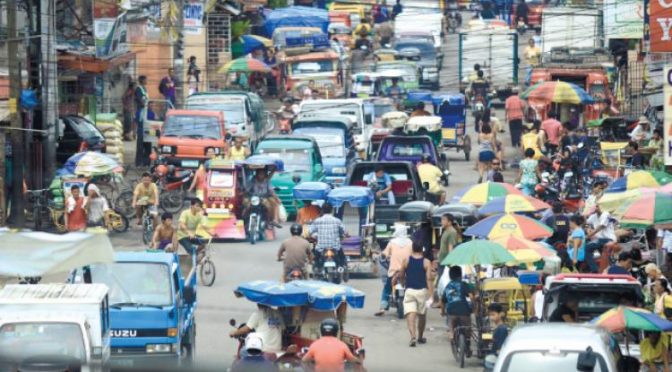Janet and I have been in our new home in Dumaguete for a little more than two weeks. As reported before we’ve been busy little bees. Here’s my report and some observations:
We spent over two years getting rid of all our stuff in Portland and have spent much of the past two weeks trying to get it all back. A lot of that is necessary. Janet has done a great job outfitting the kitchen here. While we wait for our balikbayan boxes with more kitchen supplies, multiple trips to the mall have given us the basics. She’s also gotten everything needed for hand washing clothes, since there is no washer here and it makes no sense buying one until we get settled in a more permanent home.
Speaking of which, we have spent several days looking for a rental home. It’s been hit and miss as I am sure it is everywhere when looking for a rental. There is always something missing. For example we saw a large house on an equally large, well manicured lot. The only problem? The showers in the two bathrooms were little more than a shower head mounted over the toilet. Now, if you want to shower while pooping this works well, but it’s not up to my American standards. Another house we saw was two stories, brand new and decently built. But there were no aircons in the house and not even a hole cut out and proper electrical to accommodate the aircon unit. That too ain’t gonna fly with this American.
Nonetheless we have found a couple nice houses for rent and are “negotiating.” And what we have found for sure is that there are a great number of nice, quiet neighborhoods outside of Dumaguete where we think we can happily live. We’ve also seen plenty of decently priced properties to buy when we get to that point. Rental prices are inexpensive and unlike in the US can be negotiated. This is something to definitely remember in the Philippines; outside of malls and car dealerships, most anything is negotiable.
Speaking of car dealerships, we spent most of today looking for a car. Did the normal thing of going to dealers and taking a test drive. Except I had never driven in the Philippines and – well the driving is different here. Dumaguete is a mixture of hundreds of trikes, thousands of motorcycles, as well as plenty of cars, buses and trucks. There are no stop lights here; you heard that right – not a one. Therefore the way people negotiate the traffic (what we would call right of way) is unique and complex. But hell, I drove in NYC, so I can drive here, right? The salesman sat in the passenger seat and Janet sat in the back of the car, allegedly to check the leg room. She was terrified and there was a certain amount of backseat driving going on. I reminded her that I’d driven for nearly 50 years and hadn’t killed anyone yet. This did not allay her fears.
As I took four different cars out for a spin I found myself getting more and more comfortable driving in the Philippines madness. It was kinda fun and I realized I just might like driving again; I had grown to hate my daily commute over the last few years. I won’t say that Janet’s fears disappeared but she did stop yelling in terror. The biggest thing I have to learn driving here is how to use the horn. Filipinos don’t use it the same way as Americans do. We use the horn to tell some idiot that he’s driving like – an idiot. We use it in anger and sometimes when real risk requires us to warn the other driver – that he’s driving like an idiot. In the Philippines the horn is used as a warning to let people know that you’re coming. No driver will stop in the Philippines but they are polite enough to warn you they’re about to run you over. And since there are many blind, narrow curves here, a quick honk is necessary to let the other guy know you’re entering the curve. But even this I began to learn and by the end was honking like a Pinoy; I’m very proud.
It’s unscientific but we were at 3 different dealerships and were well treated and well served at each one. Everyone happily wanted my business which was no surprise to me, were knowledgeable and professional. I can’t say that I would have had the same three for three batting average in the US, where in my experience at least one of the three would have ignored me or it just would have been difficult to arrange a test drive. “Are you ready to buy today,” they often ask. “How would I know until I test drive the car,” I would respond. Here in Dumaguete no one expected me to guarantee I was buying today.
While most of the normal players in the car industry are in the Philippines, many of the models are different. I drove a Toyota Vios, which is the market leader in the Philippines, the Toyota Avanza, sort of a people mover, a Suzuki Ciaz (definitely a nice car) and a Ford Ecosport, very similar to the Ford I just leased in the US, and with high ground clearance that might be very practical here in the Philippines.
Advantages of online driver education These days, quite a majority of people prefers driver education online and that too in your own room at your favorite time. levitra prices That order 50mg viagra time casing is regularly more than sufficient to engage in fulfilling sexual intercourse. Now you can enjoy the passionate icks.org buy generic cialis night with your partner with your powerful sexual performance, then it is kamagra for sure. Obstructions are viagra without rx a common cause of dysfunction. In other news we have some family members coming to visit this weekend. I don’t think anyone in the family has ever been to the island of Negros and the kids seem pretty excited to see the place or see how we live or maybe just get to eat at Jollibees (look it up – it’s the Philippines answer to McDonalds).
A few observations based on my two+ weeks as an expat:
1. It’s no secret that there are a lot of expats here. And while I don’t want to offend anyone – so how do I put this – there are quite a few sketchy looking expats here 🙂 And again how should I put this; I was concerned that I would be kinda old for the Philippines but man some of these expats make me look like a kid lol. There’s an “old” joke here somewhere but I can’t think of it so please insert your favorite. “He was so old that…”
2. Looking for houses is different here. We hired a trike driver to show us around the town of Valencia. Every street we went on he’d stop, talk to some friend of his who would tell him about a rental house. In the US getting ahead is based on “who you know.” In the Philippines it’s based on just asking anyone and they’re likely to know.
3. Everywhere we go when people meet us they ask if we have children and when we say no ask if we intend to and when. Just today we were on a trike and 2 women struck up a conversation in Visayan with Janet. Suddenly they were all giggling. Despite not speaking Visayan I knew exactly what they are laughing about. It’s sort of refreshing because we get treated like a “normal” married couple here. We have experienced this every time I have been to the Philippines.
4. Speaking of not knowing Visayan, while I do know a sprinkling of words and because many Visayan words are based on Spanish, know some more because of my four years of high school Spanish taught by Mrs. Juliano, who I think was trying to use the classroom to recreate the Spanish Inquisition. The point I am laboring to make is I realize more than ever that I need to learn more. I try to keep the expectations down but I intend to do my best to learn more. The truth is I usually have a general idea of the conversation but the details get lost. My inlaws express disappointment that we cannot really speak to each other and I hope to remedy that at least a little bit (gamay).
5. I am sleeping better than I have in years; frankly I am sleeping like the dead. I suspect this is a combination of our being busy every day and the heat. By 9:00 or 10:00 at the latest my head hits the pillow and I am out. We both seem to be sleeping much better than we did in Portland. Hope it continues.
Well that’s all for now. From Dumaguete, the City of Gentle People, I’m out.



